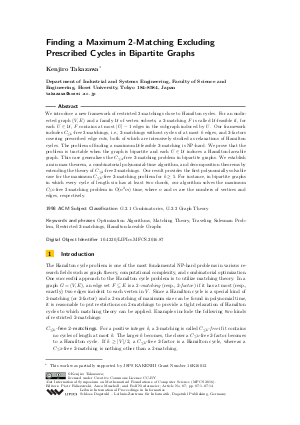Finding a Maximum 2-Matching Excluding Prescribed Cycles in Bipartite Graphs
Author Kenjiro Takazawa
-
Part of:
Volume:
41st International Symposium on Mathematical Foundations of Computer Science (MFCS 2016)
Part of: Series: Leibniz International Proceedings in Informatics (LIPIcs)
Part of: Conference: Mathematical Foundations of Computer Science (MFCS) - License:
 Creative Commons Attribution 3.0 Unported license
Creative Commons Attribution 3.0 Unported license
- Publication Date: 2016-08-19
File

PDF
LIPIcs.MFCS.2016.87.pdf
- Filesize: 0.55 MB
- 14 pages
Document Identifiers
Subject Classification
Keywords
- optimization algorithms
- matching theory
- traveling salesman problem
- restricted 2-matchings
- Hamilton-laceable graphs
Metrics
- Access Statistics
-
Total Accesses (updated on a weekly basis)
0PDF Downloads0Metadata Views
Abstract
We introduce a new framework of restricted 2-matchings close to Hamilton cycles. For an undirected graph (V,E) and a family U of vertex subsets, a 2-matching F is called U-feasible if, for each setU in U, F contains at most |setU|-1 edges in the subgraph induced by U. Our framework includes C_{<=k}-free 2-matchings, i.e., 2-matchings without cycles of at most k edges, and 2-factors covering prescribed edge cuts, both of which are intensively studied as relaxations of Hamilton cycles. The problem of finding a maximum U-feasible 2-matching is NP-hard. We prove that the problem is tractable when the graph is bipartite and each setU in U induces a Hamilton-laceable graph. This case generalizes the C_{<=4}-free 2-matching problem in bipartite graphs. We establish a min-max theorem, a combinatorial polynomial-time algorithm, and decomposition theorems by extending the theory of C_{<=4}-free 2-matchings. Our result provides the first polynomially solvable case for the maximum C_{<=k}-free 2-matching problem for k >= 5. For instance, in bipartite graphs in which every cycle of length six has at least two chords, our algorithm solves the maximum C_{<=6}-free 2-matching problem in O(n^2 m) time, where n and m are the numbers of vertices and edges, respectively.
Cite As Get BibTex
Kenjiro Takazawa. Finding a Maximum 2-Matching Excluding Prescribed Cycles in Bipartite Graphs. In 41st International Symposium on Mathematical Foundations of Computer Science (MFCS 2016). Leibniz International Proceedings in Informatics (LIPIcs), Volume 58, pp. 87:1-87:14, Schloss Dagstuhl – Leibniz-Zentrum für Informatik (2016)
https://doi.org/10.4230/LIPIcs.MFCS.2016.87
BibTex
@InProceedings{takazawa:LIPIcs.MFCS.2016.87,
author = {Takazawa, Kenjiro},
title = {{Finding a Maximum 2-Matching Excluding Prescribed Cycles in Bipartite Graphs}},
booktitle = {41st International Symposium on Mathematical Foundations of Computer Science (MFCS 2016)},
pages = {87:1--87:14},
series = {Leibniz International Proceedings in Informatics (LIPIcs)},
ISBN = {978-3-95977-016-3},
ISSN = {1868-8969},
year = {2016},
volume = {58},
editor = {Faliszewski, Piotr and Muscholl, Anca and Niedermeier, Rolf},
publisher = {Schloss Dagstuhl -- Leibniz-Zentrum f{\"u}r Informatik},
address = {Dagstuhl, Germany},
URL = {https://drops.dagstuhl.de/entities/document/10.4230/LIPIcs.MFCS.2016.87},
URN = {urn:nbn:de:0030-drops-64950},
doi = {10.4230/LIPIcs.MFCS.2016.87},
annote = {Keywords: optimization algorithms, matching theory, traveling salesman problem, restricted 2-matchings, Hamilton-laceable graphs}
}
